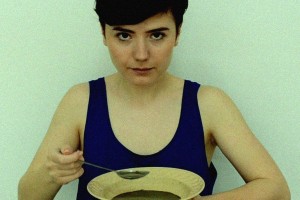Upside down – Sens dessus-dessous, the art show at the Center for Visual Arts by the renowned artist Philippe Ramette (b. 1961) is a surprise for the Bucharest art scene because it has an accuracy that could be considered “too much”, “too aesthetic”, “too well-defined”. But here we have a French artist – and a successful one at that – and nothing that I’ve stated before can be true. But we can talk about a classical and fair approach to photography that is at the border between an extraordinary and a common reality.
Although they may appear banal at first, using obvious photo manipulation techniques, Ramette’s images become that much more meaningful and profound once you learn that the artist was the performer in his own photographs and the manipulation is only limited to a small adjustment to the composition. Even though the situations themselves are not real, the general aspect of the work is to document a man that is situated in an unusual angle that also reports to it. Ramette investigates a world that is very similar to ours, with believable imaging, a world that could perhaps exist, a world waiting to be discovered. The genuineness of the images is inclusive of the viewer and sets the perspective of imminent possibility, a perspective that lures the viewer in but also pushes him away – this is the reason why his works seem constantly tensioned. Just like René Magritte’s paintings, in which the light of a lamppost seems normal during the day, magically pulling you in, Phillipe Ramette’s works have a fascinating aura that stays with you even after you left the exhibition.
In Ramette’s photography – he thinks of himself as a sculptor – the object itself is not important, but rather the future utility of said object, the viewer’s imagined relationship with the object. This object obsession, even if the object is invisible, is what really transforms the images in conceptual sculptures, despite the technique used.
The artist shows a man in waiting, a man that is situated in our world, where we see things from perspectives and angles that we consider different but are actually very similar, and a man in atypical situations that is still connected to our world via the instruments that make this anomaly possible. These instruments – metal bars, modified chairs, air balloons – are shown in the photographs, they aren’t retouched and offer an inside perspective to the viewer. Ramette is so sure about his imaginarium that he openly shows these details of normality, proving that the artist is not a super human.
The exhibition also features an object that was specially created by the artist for the space. It is a minimalist chair with the typical inverted orientation that comes as an encouragement for the viewer to switch places with the artist, the actor.
Caught in a friendly, yet dangerous relationship with nature, Ramette’s character seems to be a contemporary descendent of the character in the famous painting Wanderer above the Sea of Fog (1818) by Caspar David Friedrich. Facing the impressive wilderness, the individual takes on a playful role based on the nonsense of reality or on trying to define this nonsense from a personal perspective.
The peaceful, accepted, auto-created danger in which the artist finds himself makes one think about the individual limit, the limit of human existence. With the simple act of changing the point of view, the artist modifies the entire perception of individual goal. This danger is like Lars von Trier’s planet Melancholia – it is built so believably that the end of the world is an absolute reality for the characters and the spectators.
The exhibition Upside down – Sens dessus – dessous by Philippe Ramette puts us in an infinite state of waiting for a verdict, for a conclusion, in an in-between state, at the border between two worlds, that of definable and that of indefinable objects.
Philippe Ramette, Sens dessus – dessous / Upside down, 18 March – 11 April 2015, Centrul Artelor Vizuale, UAPR, Bucharest.
POSTED BY
Adina Mocanu
Adina Mocanu (b. 1990) lives and works in Rome, Italy, as art resident at the Academy of France in Rome - Villa Medici, together with Alexandra Sand. Since 2013, Adina Mocanu and Alexandra Sand form a...
adinamocanualexandrasandu.tumblr.com


Comments are closed here.